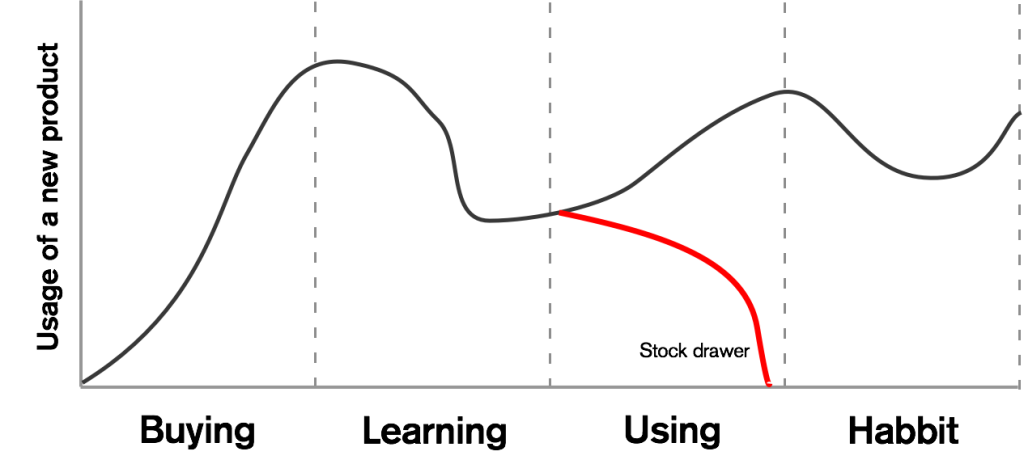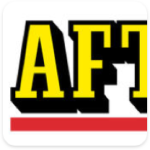I went to the Wearable TechCon in Santa Clara this week, this is a summary of the discussions we had, and also my view of this technology’s future.
If we look at wearables today I’d say we are in the beginning and it feels very much as we have a very “cool” technology but how can we use it. Dr. John Feland at Argus Insights claims that we use our wearable device for 30 days in average and then it stays in the sock drawer. It seems counting steps and getting notifications on the watch will persuade the users to wear it all the time.
This is a nice graph of an average using of a new product that you start to use. Every one wants to be a habit for the user.
Watches
I have been using a LG G WATCH R for a couple of months now and I find myself putting it on my wrist every day. The best thing is that I don’t miss any phone calls anymore and I can decide if I like to answer it or not. I use the watch to see if something important has happened and I spend less time on my phone. That feature is very small and can be achieved with a Pebble and many others……. From a media perspective notifications seem to be the big thing, Apple says in their guidelines:
If you measure interactions with your iOS app in minutes, you can expect interactions with your WatchKit app to be measured in seconds. So keep interactions brief and interfaces simple.
Apple Watch
This conference started on the day of the Apple event in San Francisco, of course the debate was high on the features and the future. It is always a big thing when Apple releases a new product, everyone who “knows the market” says it is going to fail. I´m not sure where it will head but I do think it has great potential.
Killer features
There is one question on everyone’s mind when a new category of products enter the market, what is the killer app? Or what features will become a habit for the users? Well of course there is no answer to that kind of question. But I strongly believe in a big selection of wearable devices. Products like Ringly notifies you about the events on your phone that matter most. Misfit shine is an activity and sleep tracker that syncs with your phone. And there are many more to come.
Identification
To me the most interesting part of Wearable devices is identification. Companies like Nymi shows that the pulse is as unique as your fingerprint. In our daily life, we need to identify ourselves several times a day in different ways. Think about keys, passwords, payments and more. All of that is me saying: This is me lets do this.
The Apple watch has this identification system as well, you authorize Apple Pay with a password or your fingerprint and the watch is smart enough to know when you take it off. It will ask you to enter the passcode next time you put it back on to prevent someone else from making payments with it.
Let’s be serious about privacy
With all this technology and new data points the machines will be able to know who we are. That is extremely powerful and risky. As we put more of our person and private self online we expose ourselves, take the “celebrity photo hack” in 2014 for example, passwords are poor protection. Mostly because people do not change them and they are very easy to hack in most cases. It is just a hassle…
I hear often someone from the older generation say “young people don’t understand integrity” and I think that is just a reflects the people who say it. It is not a coincidence that Snapchat is the fastest growing social media today. They say “Delete is our default” and take a very strong position on not saving any data. It is primarily kids and young adults who use it. Snapchat is one example but both Apple and Pebble take this very seriously , they do not sell data to advertisers at all.
When people are talking about “data is the new gold” companies like Facebook and Google are the biggest examples. They collect data quite aggressively and to me it seems that privacy is not their biggest concern.
That kind of data is very interesting but if you look at the credit card companies like MasterCard or American Express they knew everything about you. And I would claim that the older generation is the frequent users of the credit cards.
Transparency is essential, what kind of data do you collect and why. Most users do not read the terms and conditions section when signing up for a new product. But to be fair, they are not written in a way that is readable for a user, it is very poor UX. If you think transparency is important, make it readable and make sure everyone reads it. The lazy way is to put up a tree pages long document, just to be on the safe side and I have a feeling that you want to hide something. To be transparent is in my humble opinion, to make the terms and conditions accessible and presented in a readable version with a summary.
I come from a UX background and that will always be my main priority, how can we provide the user with a better experience is the key question.


